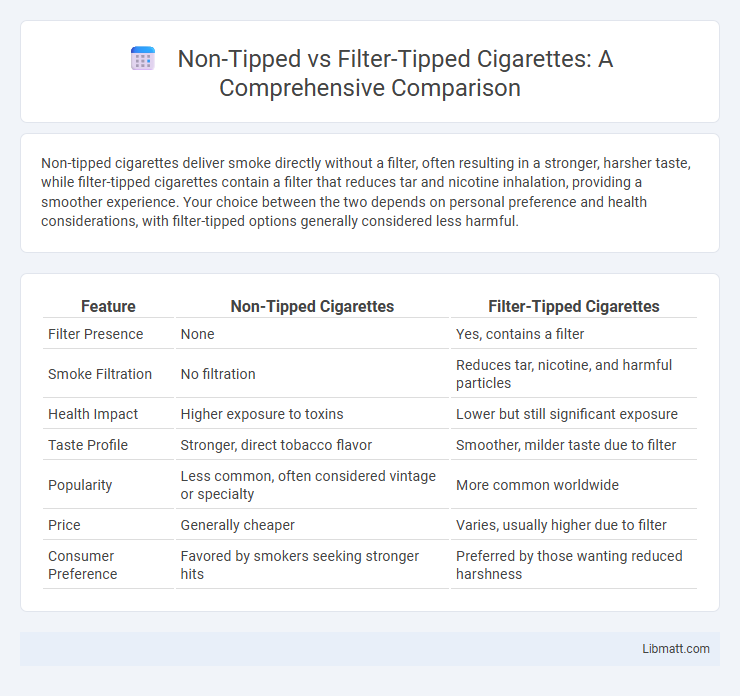Non-tipped cigarettes deliver smoke directly without a filter, often resulting in a stronger, harsher taste, while filter-tipped cigarettes contain a filter that reduces tar and nicotine inhalation, providing a smoother experience. Your choice between the two depends on personal preference and health considerations, with filter-tipped options generally considered less harmful.
Table of Comparison
| Feature | Non-Tipped Cigarettes | Filter-Tipped Cigarettes |
|---|---|---|
| Filter Presence | None | Yes, contains a filter |
| Smoke Filtration | No filtration | Reduces tar, nicotine, and harmful particles |
| Health Impact | Higher exposure to toxins | Lower but still significant exposure |
| Taste Profile | Stronger, direct tobacco flavor | Smoother, milder taste due to filter |
| Popularity | Less common, often considered vintage or specialty | More common worldwide |
| Price | Generally cheaper | Varies, usually higher due to filter |
| Consumer Preference | Favored by smokers seeking stronger hits | Preferred by those wanting reduced harshness |
Introduction to Non-Tipped vs Filter-Tipped Cigarettes
Non-tipped cigarettes consist of a uniform tobacco rod without a cellulose acetate filter, resulting in a harsher smoke and higher tar intake. Filter-tipped cigarettes feature a cellulose acetate filter designed to reduce tar, nicotine, and particulate matter inhaled by smokers. The use of filter-tipped cigarettes has become standard due to evolving health regulations and consumer preference for smoother smoking experiences.
Historical Evolution of Cigarette Tips
Non-tipped cigarettes dominated the early 20th century market, with unfiltered tobacco smoke delivering a harsher and more concentrated nicotine intake. By the 1950s, growing health concerns and consumer demand prompted the invention of filter-tipped cigarettes, which incorporated cellulose acetate filters designed to reduce tar and nicotine absorption. The transition marked a significant advancement in cigarette manufacturing technology, aiming to mitigate some health risks despite continued tobacco-related dangers.
Key Differences Between Non-Tipped and Filter-Tipped Cigarettes
Non-tipped cigarettes are characterized by tobacco exposed at the mouth end, allowing direct contact with the tobacco filler, while filter-tipped cigarettes feature a cellulose acetate filter designed to reduce tar and nicotine inhalation. The presence of filters in filter-tipped cigarettes significantly influences smoking experience by altering smoke temperature and particle size, potentially lowering exposure to harmful chemicals compared to non-tipped variants. Key differences include the effectiveness of filter material in trapping toxicants, impact on flavor perception, and consumer preferences driven by perceived health risks and smoking behavior patterns.
Health Implications: Non-Tipped vs Filter-Tipped
Non-tipped cigarettes expose smokers to higher levels of tar, nicotine, and harmful toxins due to the absence of a filtration barrier, increasing the risk of respiratory diseases and cancers. Filter-tipped cigarettes reduce the inhalation of some harmful substances by trapping certain particulates, but they do not eliminate risks associated with smoking. Understanding these health implications can help you make more informed choices regarding tobacco use.
Smoking Experience and Flavor Profiles
Non-tipped cigarettes deliver a stronger, more intense smoking experience due to direct contact with the tobacco, often resulting in a bolder, richer flavor profile. Filter-tipped cigarettes reduce harshness by cooling and filtering the smoke, offering a smoother taste with subtler, more refined flavor notes. Your preference for intensity versus smoothness will determine which type enhances your smoking experience most effectively.
Popularity and Market Trends
Non-tipped cigars maintain popularity among traditional smokers who prefer an unadulterated tobacco experience, while filter-tipped cigars gain traction among younger demographics seeking a milder, more convenient option. Market trends indicate a steady increase in demand for filter-tipped cigars due to enhanced filtration technology and growing health-conscious consumer segments. Sales data from recent years highlight a significant growth rate in filter-tipped cigar segments, reflecting shifting preferences and evolving smoking habits.
Environmental Impact of Cigarette Filters
Non-tipped cigarettes lack the cellulose acetate filters found in filter-tipped varieties, resulting in a different environmental profile. Filter-tipped cigarettes contribute significantly to pollution as their plastic-based filters are non-biodegradable and often discarded improperly, leading to widespread litter and toxic chemical leaching into ecosystems. In contrast, non-tipped cigarettes avoid this specific pollution source but still generate hazardous tobacco waste and pose health risks.
Cost Comparison: Non-Tipped vs Filter-Tipped
Non-tipped cigarettes generally cost less than filter-tipped ones due to simpler manufacturing processes and lower material expenses. Filter-tipped cigarettes, incorporating extra materials like cellulose acetate filters, incur higher production costs which reflect in their retail prices. Your choice between non-tipped and filter-tipped options can impact overall spending depending on quantity and brand preferences.
Cultural Perceptions and Preferences
Non-tipped cigarettes often carry a perception of being more traditional or authentic in certain cultures, while filter-tipped variants are widely associated with health consciousness and modern smoking habits. Your choice may reflect cultural values, as filter tips are preferred in regions emphasizing harm reduction, whereas non-tipped versions might be favored where ruggedness or classic appeal is culturally significant. These preferences shape marketing strategies and consumer acceptance globally.
Future Outlook of Cigarette Tip Technology
Non-tipped cigarettes primarily consist of a simple rolling paper around tobacco, while filter-tipped versions incorporate materials designed to reduce tar and nicotine intake. Advances in cigarette tip technology are focusing on developing bio-based and more effective filtration systems to minimize health risks and environmental impact. Your choice of cigarette tip may evolve as innovations prioritize enhanced filtration efficiency and sustainability in the future.
non-tipped vs filter-tipped Infographic

 libmatt.com
libmatt.com